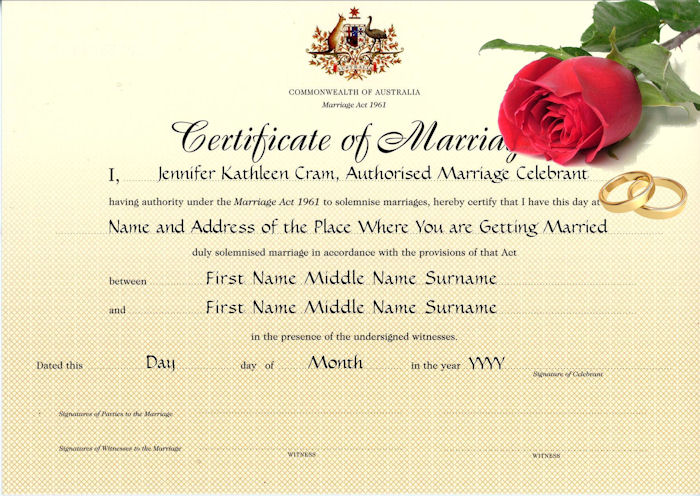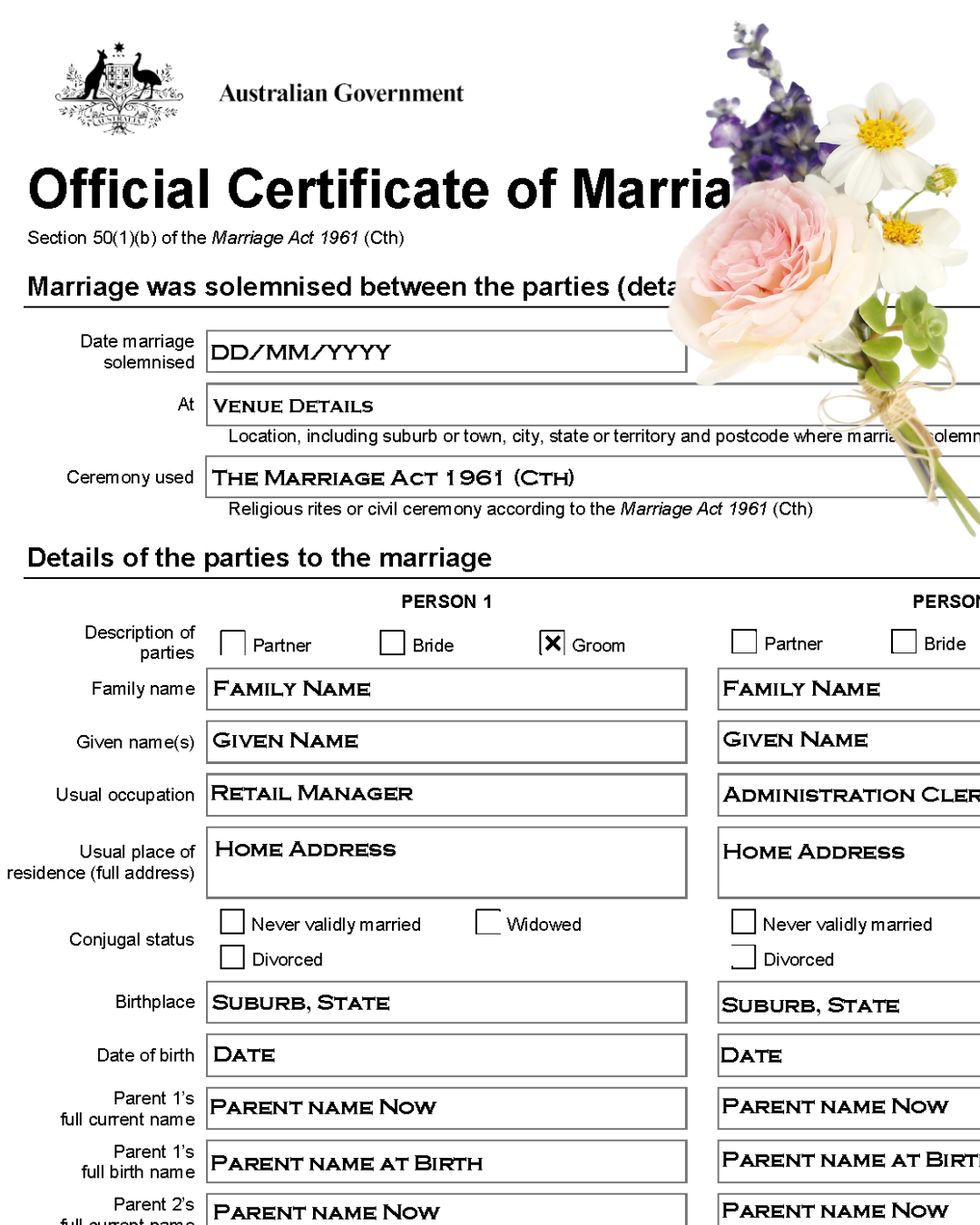Your Marriage
Certificate(s)
Categories: | Marriage Paperwork | Wedding Ceremony | Wedding Legals |
 One of the more common questions I
am asked by couples, particularly those who are
coming from overseas to get married in Australia,
is "Will we get a certificate to prove that we
are married?" And very occasionally I
am asked whether the certificate I present to the
couple on their wedding day is an official one.The
short answer to both of those questions is Yes.
One of the more common questions I
am asked by couples, particularly those who are
coming from overseas to get married in Australia,
is "Will we get a certificate to prove that we
are married?" And very occasionally I
am asked whether the certificate I present to the
couple on their wedding day is an official one.The
short answer to both of those questions is Yes.The long answer is Yes, you will be given an official certificate on the day, but you will actually need two certificates, the one you get on the day, which proves that a marriage ceremony took place, and one you apply for from Births, Deaths, and Marriages in the State or Territory in which you got married, which proves that your marriage has been registered.
The Presentation
Certificate
out
On your wedding day, you must be given a
certificate with the Commonwealth Coat of Arms on
it. This certificate is generally referred to as
The Presentation Certificate. Occasionally it
might be called the Celebrant Certificate. But it
is officially the Form 15 CertificateThe presentation certificate pictured above is the version you will receive when you are married by an authorised civil marriage celebrant or by a marriage officer at a registry office or courthouse. If married by a clergy person in a religious ceremony, your certificate will have an extra few words "and according to the rites of ......" and a line on which will be recorded the name of the religious denomination.
While your Presentation Certificate is a legal document that is proof that your marriage ceremony took place, it is also a very significant historical record because it is the only official document you will have that has actual signatures on it.
What you need to know
about the Presentation Certificate
out
- While it is conclusive proof that your marriage took place, something that is spelled out in detail on the back of the certificate, it is not proof that your marriage has been registered
- It is also not proof of your identity
- It is cross-hatched over the lower part of the certificate and printed with fugitive inks, so any attempt to alter the certificate immediately becomes very obvious
- After the two of you, your two witnesses, and your celebrant have signed it (which must happen as soon as practicable after your marriage is solemnised) you will be given it to keep.
- You cannot get a replacement copy,
regardless of what happened to the original,
so keep it safe! And if you're wondering why,
it is because the certificate records an event
on a particular day as reflected in the
wording on the actual certificate - “I
[Celebrant] having authority under the
Marriage Act 1961 to solemnise
marriages, hereby certify
that I have on this day
at [place] duly solemnised marriage…”
- It is a legal document, so you should store it securely
- Your celebrant is required to keep a record of how each certificate was used - so the number of the certificate you were given (you'll find it on the back, top right hand corner), together with your names, will be entered into the celebrant's records
- Some state registry offices require the celebrant to disclose the Presentation Certificate Number when submitting your marriage details for registration of your marriage.
- While many organisations will accept your
Presentation Certificate as proof of marriage
or of change of name, many, including
Government Departments, won't, so you will
need to apply for a copy of the Official
Marriage Certificate
The Official Marriage
Certificate
out
 On the day you will sign two copies
of a document that is headed "Official Marriage
Certificate". The information on this document
will be part of the record of your marriage held
by Births, Deaths and Marriages in the state or
territory in which you were married. Once your
marriage has been registered, you will be able to
get a certified copy (an official marriage
certificate), for a fee. Each BDM has its
own rules about making an application, which is
set out on its website. Strict privacy provisions
also apply.
On the day you will sign two copies
of a document that is headed "Official Marriage
Certificate". The information on this document
will be part of the record of your marriage held
by Births, Deaths and Marriages in the state or
territory in which you were married. Once your
marriage has been registered, you will be able to
get a certified copy (an official marriage
certificate), for a fee. Each BDM has its
own rules about making an application, which is
set out on its website. Strict privacy provisions
also apply.When I submit your marriage papers for registration of your marriage I can notify BDM that you wish to order an official certificate.
Things you need to know
about the Official Certificate
out
- Your official marriage certificate is proof
that your marriage has been registered
- It is also proof of your identity
- An official marriage certificate, as issued by Births, Deaths, and Marriages, is an "original" document that is a copy of information recorded in the Register of Marriages kept by Births, Deaths, and Marriages
- While many organisations will accept your Presentation Certificate, or a JP certified copy of it, for most official purposes you will need an Official Marriage Certificate. These purposes include:
- Changing your name on your driver licence
- Changing your name on your passport
- Proving to Immigration Authorities that you are married in fulfilment of the requirements of a Prospective Marriage Visa (Fiance Visa)
- Applying for Spouse Visa
- Changing your name with Medicare, Centrelink etc
- Notification of name and/or marital status to financial institutions, superannuation, etc
- Generally speaking, only the two of you may
apply for a copy of your Official Marriage
Certificate for the first 75 years you are
married!
One word of advice
out
Endless problems are caused when information on
your marriage certificate is incorrect. So, don't just rely on your celebrant to get it right.
- Make sure you complete your Notice of
Intended Marriage accurately - it is your
responsibility to provide information that is
both complete and correct. Check everything
against your birth certificates and other ID
documents. Twice!
- Check your certificates thoroughly before you sign them (I give my couples proof copies of their certificates to check before the day). Make sure your celebrant does that too.
And in case you're
wondering
out
There will be five signatures on each certificate
- the two of you, your two legal witnesses, and
your celebrant. No more and no less. The Marriage
Act allows for only two official legal witnesses.
So it is not legal to have more than two witnesses
or to allow your
guests to also sign the certificate. Additional
signatures could invalidate the document.Related Information
out
Thanks for reading!
Things